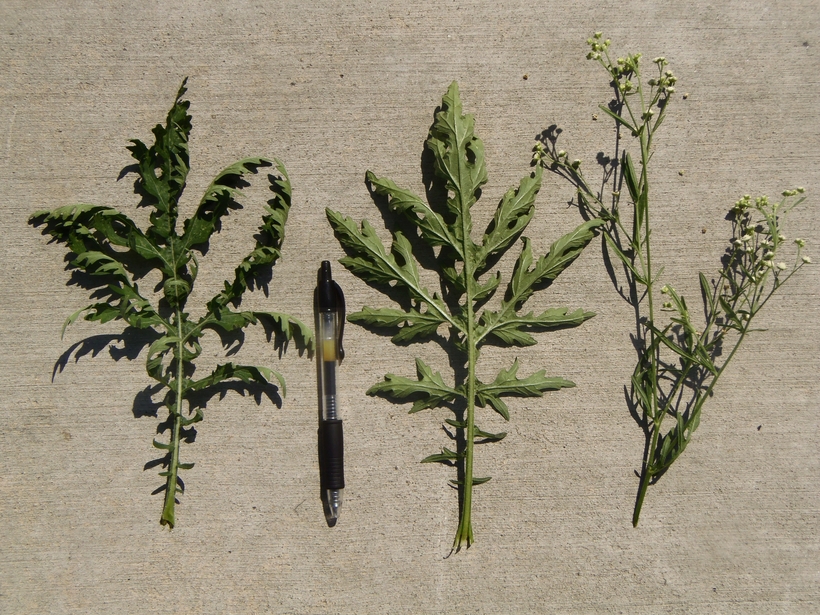Created by: Elizabeth D. Brusati
Created on: Wednesday, Jan 27th, 2016
Created on: Wednesday, Jan 27th, 2016
Yes or No:
Yes
Points:
1
Confidence Level:
Very High
Answer / Justification:
California, Hawaii, midwestern/eastern/southern US, Africa, Asia, Australia, Pacific Islands. (Native to Mexico and much of South America.)
Reference(s):
Yes or No:
Yes
Points:
2
Confidence Level:
Very High
Answer / Justification:
One record from an agricultural field at UC Riverside in 1981. A second colony was recently detected and confirmed by CDFA in Santa Ana, Orange County, CA. A third very small infestation of two plants has also been detected in Irvine, Orange County, CA. Naturalized in the KwaZulu-Natal region of South Africa, which matches California.
Reference(s):
Yes or No:
Yes
Points:
2
Confidence Level:
Very High
Answer / Justification:
Aggressively colonizes disturbed sites. Affects the production of crops. Invasive in northern KwaZulu-Natal, South Africa, where it is called famine weed due to its (potential?) impacts on crops. Noxious weed in Puerto Rico. Invasive in India, environmental weed in Australia (Randall 2012). CABI says it's a declared noxious weed in Queensland, AU, but the Queensland website says only that it invades pastures, floodplains, grasslands, open woodlands, waste areas, disturbed sites, lawns, gardens and crops (no legal listing).
Reference(s):
Yes or No:
Yes
Points:
3
Confidence Level:
High
Answer / Justification:
Invasive in northern KwaZulu-Natal, South Africa, where it is called famine weed due to its (potential?) impacts on crops.
Reference(s):
Yes or No:
No
Points:
0
Confidence Level:
Medium
Answer / Justification:
Randall 2012 lists several other Parthenium spp as weeds (agricultural) but I could not find details.
Reference(s):
Yes or No:
No
Points:
0
Confidence Level:
Medium
Answer / Justification:
Prefers climates classified as Cf, Cs, Cw in the Trewartha-Koppen climate system. Cs = Warm average temp. > 10°C, Cold average temp. > 0°C, dry summers (according to CABI data). These are climate zones that match California. However, most locations on GBIF map (http://www.gbif.org/species/3086784) are in portions of Central America, South America, Asia and Australia that do not match California based on Cal-IPC's climate map.
Reference(s):
Yes or No:
Yes
Points:
1
Confidence Level:
Very High
Answer / Justification:
Allelopathic properties allow it to suppress native vegetation in a wide range of habitats.
Reference(s):
Yes or No:
No
Points:
0
Confidence Level:
Very High
Answer / Justification:
Can find no mention of this, despite the thorough description in the CABI datasheet.
Reference(s):
Yes or No:
Yes
Points:
1
Confidence Level:
Very High
Answer / Justification:
This weed is considered to be a cause of allergic respiratory problems, contact dermatitis, mutagenicity in human and livestock. Crop production is drastically reduced owing to its allelopathy.
Reference(s):
Yes or No:
No
Points:
0
Confidence Level:
High
Answer / Justification:
Based on herbarium specimens in Tropicos, and that it's an annual herb, it does not seem large enough to create 'impenetrable" thickets.
Reference(s):
Yes or No:
No
Points:
0
Confidence Level:
Very High
Answer / Justification:
It is unable to reproduce vegetatively from plant parts or by apomixis.
Reference(s):
Yes or No:
No
Points:
0
Confidence Level:
Very High
Answer / Justification:
It is unable to reproduce vegetatively from plant parts or by apomixis.
Reference(s):
Yes or No:
Yes
Points:
1
Confidence Level:
Very High
Answer / Justification:
A prolific seed producer. Produces 10,000 to 15,000 viable seeds per plant.
Reference(s):
Yes or No:
Yes
Points:
1
Confidence Level:
Very High
Answer / Justification:
Produces 10,000 to 15,000 viable seeds per plant.
Reference(s):
Yes or No:
Yes
Points:
1
Confidence Level:
Very High
Answer / Justification:
In Australia, parthenium weed germinates mainly in spring and early summer. It produces flowers and seeds throughout its life and dies in late autumn. Flowering may begin as early as 4 weeks after seedling emergence and plants continue to flower for extended periods (6-8 months) when conditions permit.
Reference(s):
Yes or No:
Yes
Points:
1
Confidence Level:
High
Answer / Justification:
Yes. Annual or short-lived perennial so it must produce seeds within the first three years.
Reference(s):
Yes or No:
Yes
Points:
1
Confidence Level:
High
Answer / Justification:
In Australia, parthenium weed germinates mainly in spring and early summer. It produces flowers and seeds throughout its life and dies in late autumn. Flowering may begin as early as 4 weeks after seedling emergence and plants continue to flower for extended periods (6-8 months) when conditions permit.
Reference(s):
Yes or No:
Yes
Points:
1
Confidence Level:
Very High
Answer / Justification:
Has small and light seeds that are capable of long distance travel via wind, water, birds, vehicles, farm machinery and other animal traffic.
Reference(s):
Yes or No:
Yes
Points:
1
Confidence Level:
Very High
Answer / Justification:
Has small and light seeds that are capable of long distance travel via wind, water, birds, vehicles, farm machinery and other animal traffic.
Reference(s):
Yes or No:
Yes
Points:
1
Confidence Level:
Very High
Answer / Justification:
Has small and light seeds that are capable of long distance travel via wind, water, birds, vehicles, farm machinery and other animal traffic. Also transported in garden waste.
Reference(s):
Reviewed by Barbara Castro, CA Dept of Water Resources
Direct link to CABI datasheet, Updated 4 Nov. 2015. http://www.cabi.org/isc/datasheet/45573
Queensland factsheet:
- < 13 : accept (low risk of invasiveness)
- 13 - 15 : evaluate further
- > 15 : reject (high risk of invasiveness)
PRE Score:
18
Number of questions answered:
20
Screener Confidence (%):
92.0
Organization:
Evaluation visibility:
Public - accessible to all site users

